Yifeng Zhang
Effect of Gait Design on Proprioceptive Sensing of Terrain Properties in a Quadrupedal Robot
Sep 26, 2025Abstract:In-situ robotic exploration is an important tool for advancing knowledge of geological processes that describe the Earth and other Planetary bodies. To inform and enhance operations for these roving laboratories, it is imperative to understand the terramechanical properties of their environments, especially for traversing on loose, deformable substrates. Recent research suggested that legged robots with direct-drive and low-gear ratio actuators can sensitively detect external forces, and therefore possess the potential to measure terrain properties with their legs during locomotion, providing unprecedented sampling speed and density while accessing terrains previously too risky to sample. This paper explores these ideas by investigating the impact of gait on proprioceptive terrain sensing accuracy, particularly comparing a sensing-oriented gait, Crawl N' Sense, with a locomotion-oriented gait, Trot-Walk. Each gait's ability to measure the strength and texture of deformable substrate is quantified as the robot locomotes over a laboratory transect consisting of a rigid surface, loose sand, and loose sand with synthetic surface crusts. Our results suggest that with both the sensing-oriented crawling gait and locomotion-oriented trot gait, the robot can measure a consistent difference in the strength (in terms of penetration resistance) between the low- and high-resistance substrates; however, the locomotion-oriented trot gait contains larger magnitude and variance in measurements. Furthermore, the slower crawl gait can detect brittle ruptures of the surface crusts with significantly higher accuracy than the faster trot gait. Our results offer new insights that inform legged robot "sensing during locomotion" gait design and planning for scouting the terrain and producing scientific measurements on other worlds to advance our understanding of their geology and formation.
The Primacy of Magnitude in Low-Rank Adaptation
Jul 09, 2025Abstract:Low-Rank Adaptation (LoRA) offers a parameter-efficient paradigm for tuning large models. While recent spectral initialization methods improve convergence and performance over the naive "Noise & Zeros" scheme, their extra computational and storage overhead undermines efficiency. In this paper, we establish update magnitude as the fundamental driver of LoRA performance and propose LoRAM, a magnitude-driven "Basis & Basis" initialization scheme that matches spectral methods without their inefficiencies. Our key contributions are threefold: (i) Magnitude of weight updates determines convergence. We prove low-rank structures intrinsically bound update magnitudes, unifying hyperparameter tuning in learning rate, scaling factor, and initialization as mechanisms to optimize magnitude regulation. (ii) Spectral initialization succeeds via magnitude amplification. We demystify that the presumed knowledge-driven benefit of the spectral component essentially arises from the boost in the weight update magnitude. (iii) A novel and compact initialization strategy, LoRAM, scales deterministic orthogonal bases using pretrained weight magnitudes to simulate spectral gains. Extensive experiments show that LoRAM serves as a strong baseline, retaining the full efficiency of LoRA while matching or outperforming spectral initialization across benchmarks.
Preference-Driven Multi-Objective Combinatorial Optimization with Conditional Computation
Jun 10, 2025Abstract:Recent deep reinforcement learning methods have achieved remarkable success in solving multi-objective combinatorial optimization problems (MOCOPs) by decomposing them into multiple subproblems, each associated with a specific weight vector. However, these methods typically treat all subproblems equally and solve them using a single model, hindering the effective exploration of the solution space and thus leading to suboptimal performance. To overcome the limitation, we propose POCCO, a novel plug-and-play framework that enables adaptive selection of model structures for subproblems, which are subsequently optimized based on preference signals rather than explicit reward values. Specifically, we design a conditional computation block that routes subproblems to specialized neural architectures. Moreover, we propose a preference-driven optimization algorithm that learns pairwise preferences between winning and losing solutions. We evaluate the efficacy and versatility of POCCO by applying it to two state-of-the-art neural methods for MOCOPs. Experimental results across four classic MOCOP benchmarks demonstrate its significant superiority and strong generalization.
DiscoVLA: Discrepancy Reduction in Vision, Language, and Alignment for Parameter-Efficient Video-Text Retrieval
Jun 10, 2025Abstract:The parameter-efficient adaptation of the image-text pretraining model CLIP for video-text retrieval is a prominent area of research. While CLIP is focused on image-level vision-language matching, video-text retrieval demands comprehensive understanding at the video level. Three key discrepancies emerge in the transfer from image-level to video-level: vision, language, and alignment. However, existing methods mainly focus on vision while neglecting language and alignment. In this paper, we propose Discrepancy Reduction in Vision, Language, and Alignment (DiscoVLA), which simultaneously mitigates all three discrepancies. Specifically, we introduce Image-Video Features Fusion to integrate image-level and video-level features, effectively tackling both vision and language discrepancies. Additionally, we generate pseudo image captions to learn fine-grained image-level alignment. To mitigate alignment discrepancies, we propose Image-to-Video Alignment Distillation, which leverages image-level alignment knowledge to enhance video-level alignment. Extensive experiments demonstrate the superiority of our DiscoVLA. In particular, on MSRVTT with CLIP (ViT-B/16), DiscoVLA outperforms previous methods by 1.5% in R@1, reaching a final score of 50.5% R@1. The code is available at https://github.com/LunarShen/DsicoVLA.
FastVID: Dynamic Density Pruning for Fast Video Large Language Models
Mar 14, 2025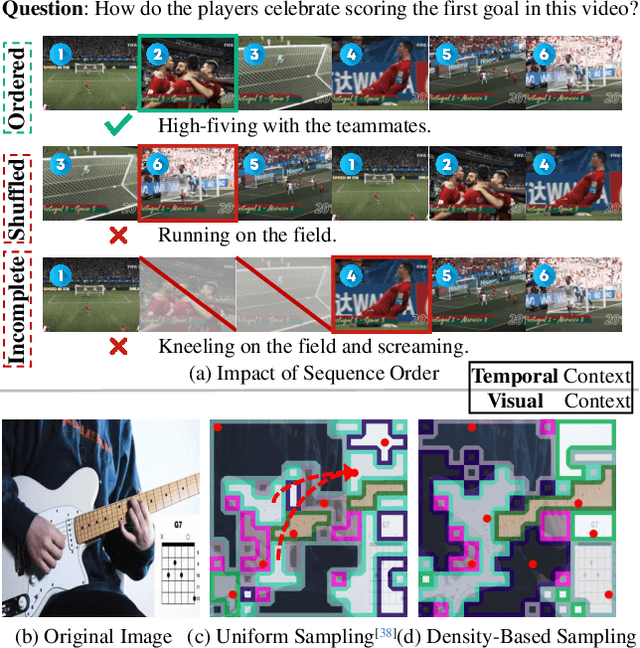
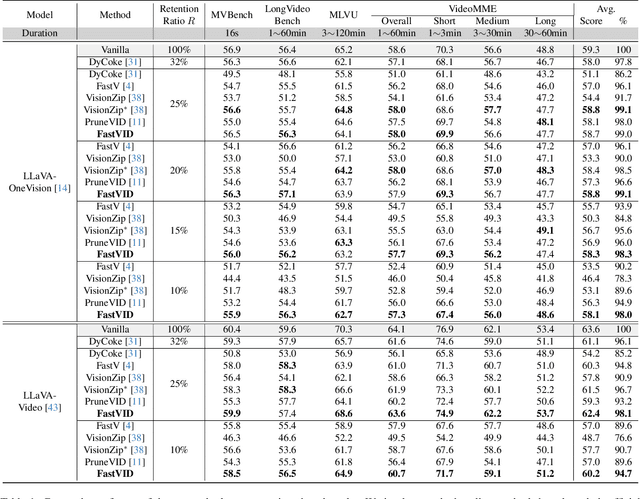
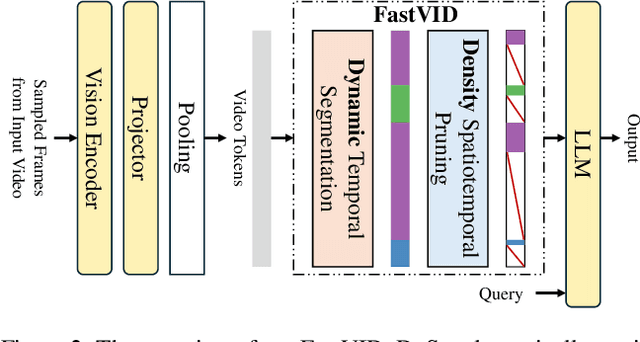

Abstract:Video Large Language Models have shown impressive capabilities in video comprehension, yet their practical deployment is hindered by substantial inference costs caused by redundant video tokens. Existing pruning techniques fail to fully exploit the spatiotemporal redundancy inherent in video data. To bridge this gap, we perform a systematic analysis of video redundancy from two perspectives: temporal context and visual context. Leveraging this insight, we propose Dynamic Density Pruning for Fast Video LLMs termed FastVID. Specifically, FastVID dynamically partitions videos into temporally ordered segments to preserve temporal structure and applies a density-based token pruning strategy to maintain essential visual information. Our method significantly reduces computational overhead while maintaining temporal and visual integrity. Extensive evaluations show that FastVID achieves state-of-the-art performance across various short- and long-video benchmarks on leading Video LLMs, including LLaVA-OneVision and LLaVA-Video. Notably, FastVID effectively prunes 90% of video tokens while retaining 98.0% of LLaVA-OneVision's original performance. The code is available at https://github.com/LunarShen/FastVID.
LLaVA-MLB: Mitigating and Leveraging Attention Bias for Training-Free Video LLMs
Mar 14, 2025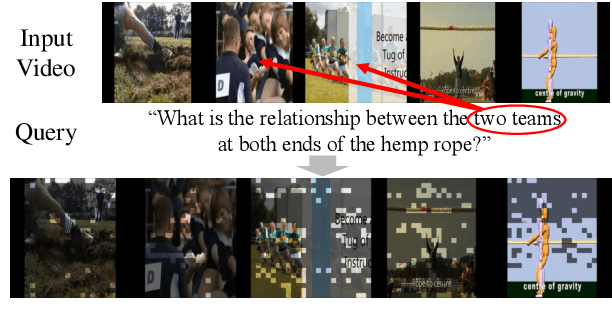

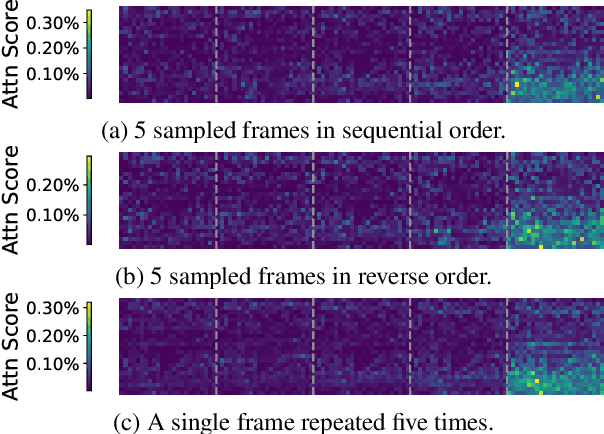
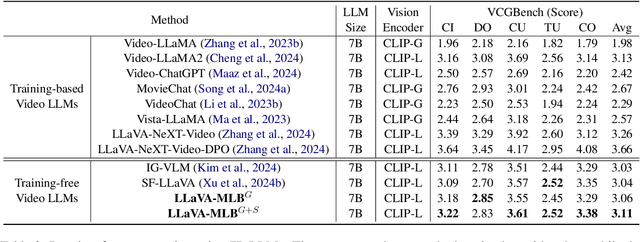
Abstract:Training-free video large language models (LLMs) leverage pretrained Image LLMs to process video content without the need for further training. A key challenge in such approaches is the difficulty of retaining essential visual and temporal information, constrained by the token limits in Image LLMs. To address this, we propose a two-stage method for selecting query-relevant tokens based on the LLM attention scores: compressing the video sequence and then expanding the sequence. However, during the compression stage, Image LLMs often exhibit a positional attention bias in video sequences, where attention is overly concentrated on later frames, causing early-frame information to be underutilized. To alleviate this attention bias during sequence compression, we propose Gridded Attention Pooling for preserving spatiotemporal structure. Additionally, we introduce Visual Summarization Tail to effectively utilize this bias, facilitating overall video understanding during sequence expansion. In this way, our method effectively Mitigates and Leverages attention Bias (LLaVA-MLB), enabling the frozen Image LLM for detailed video understanding. Experiments on several benchmarks demonstrate that our approach outperforms state-of-the-art methods, achieving superior performance in both efficiency and accuracy. Our code will be released.
Unicorn: A Universal and Collaborative Reinforcement Learning Approach Towards Generalizable Network-Wide Traffic Signal Control
Mar 14, 2025Abstract:Adaptive traffic signal control (ATSC) is crucial in reducing congestion, maximizing throughput, and improving mobility in rapidly growing urban areas. Recent advancements in parameter-sharing multi-agent reinforcement learning (MARL) have greatly enhanced the scalable and adaptive optimization of complex, dynamic flows in large-scale homogeneous networks. However, the inherent heterogeneity of real-world traffic networks, with their varied intersection topologies and interaction dynamics, poses substantial challenges to achieving scalable and effective ATSC across different traffic scenarios. To address these challenges, we present Unicorn, a universal and collaborative MARL framework designed for efficient and adaptable network-wide ATSC. Specifically, we first propose a unified approach to map the states and actions of intersections with varying topologies into a common structure based on traffic movements. Next, we design a Universal Traffic Representation (UTR) module with a decoder-only network for general feature extraction, enhancing the model's adaptability to diverse traffic scenarios. Additionally, we incorporate an Intersection Specifics Representation (ISR) module, designed to identify key latent vectors that represent the unique intersection's topology and traffic dynamics through variational inference techniques. To further refine these latent representations, we employ a contrastive learning approach in a self-supervised manner, which enables better differentiation of intersection-specific features. Moreover, we integrate the state-action dependencies of neighboring agents into policy optimization, which effectively captures dynamic agent interactions and facilitates efficient regional collaboration. Our results show that Unicorn outperforms other methods across various evaluation metrics, highlighting its potential in complex, dynamic traffic networks.
Detecting Defective Wafers Via Modular Networks
Jan 06, 2025



Abstract:The growing availability of sensors within semiconductor manufacturing processes makes it feasible to detect defective wafers with data-driven models. Without directly measuring the quality of semiconductor devices, they capture the modalities between diverse sensor readings and can be used to predict key quality indicators (KQI, \textit{e.g.}, roughness, resistance) to detect faulty products, significantly reducing the capital and human cost in maintaining physical metrology steps. Nevertheless, existing models pay little attention to the correlations among different processes for diverse wafer products and commonly struggle with generalizability issues. To enable generic fault detection, in this work, we propose a modular network (MN) trained using time series stage-wise datasets that embodies the structure of the manufacturing process. It decomposes KQI prediction as a combination of stage modules to simulate compositional semiconductor manufacturing, universally enhancing faulty wafer detection among different wafer types and manufacturing processes. Extensive experiments demonstrate the usefulness of our approach, and shed light on how the compositional design provides an interpretable interface for more practical applications.
SSD4Rec: A Structured State Space Duality Model for Efficient Sequential Recommendation
Sep 02, 2024



Abstract:Sequential recommendation methods are crucial in modern recommender systems for their remarkable capability to understand a user's changing interests based on past interactions. However, a significant challenge faced by current methods (e.g., RNN- or Transformer-based models) is to effectively and efficiently capture users' preferences by modeling long behavior sequences, which impedes their various applications like short video platforms where user interactions are numerous. Recently, an emerging architecture named Mamba, built on state space models (SSM) with efficient hardware-aware designs, has showcased the tremendous potential for sequence modeling, presenting a compelling avenue for addressing the challenge effectively. Inspired by this, we propose a novel generic and efficient sequential recommendation backbone, SSD4Rec, which explores the seamless adaptation of Mamba for sequential recommendations. Specifically, SSD4Rec marks the variable- and long-length item sequences with sequence registers and processes the item representations with bidirectional Structured State Space Duality (SSD) blocks. This not only allows for hardware-aware matrix multiplication but also empowers outstanding capabilities in variable-length and long-range sequence modeling. Extensive evaluations on four benchmark datasets demonstrate that the proposed model achieves state-of-the-art performance while maintaining near-linear scalability with user sequence length. Our code is publicly available at https://github.com/ZhangYifeng1995/SSD4Rec.
TempMe: Video Temporal Token Merging for Efficient Text-Video Retrieval
Sep 02, 2024Abstract:Most text-video retrieval methods utilize the text-image pre-trained CLIP as a backbone, incorporating complex modules that result in high computational overhead. As a result, many studies focus on efficient fine-tuning. The primary challenge in efficient adaption arises from the inherent differences between image and video modalities. Each sampled video frame must be processed by the image encoder independently, which increases complexity and complicates practical deployment. Although existing efficient methods fine-tune with small trainable parameters, they still incur high inference costs due to the large token number. In this work, we argue that temporal redundancy significantly contributes to the model's high complexity due to the repeated information in consecutive frames. Existing token compression methods for image models fail to solve the unique challenges, as they overlook temporal redundancy across frames. To tackle these problems, we propose Temporal Token Merging (TempMe) to reduce temporal redundancy. Specifically, we introduce a progressive multi-granularity framework. By gradually combining neighboring clips, we merge temporal tokens across different frames and learn video-level features, leading to lower complexity and better performance. Extensive experiments validate the superiority of our TempMe. Compared to previous efficient text-video retrieval methods, TempMe significantly reduces output tokens by 95% and GFLOPs by 51%, while achieving a 1.8X speedup and a 4.4% R-Sum improvement. Additionally, TempMe exhibits robust generalization capabilities by integrating effectively with both efficient and full fine-tuning methods. With full fine-tuning, TempMe achieves a significant 7.9% R-Sum improvement, trains 1.57X faster, and utilizes 75.2% GPU memory usage. Our code will be released.
 Add to Chrome
Add to Chrome Add to Firefox
Add to Firefox Add to Edge
Add to Edge